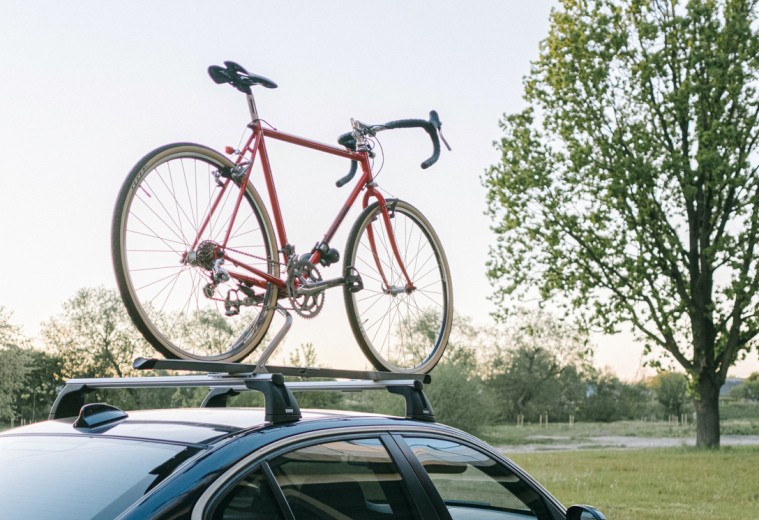However, ahead of your road trip, there are several key factors you need to consider that can be found in this helpful how to guide.
What are the different types of bike racks?
If this is the first time you are planning on attaching a bike rack, it is important to know what style is needed.
There are three main types of rack – rear mounted, tow bar, and roof – and users should be aware of the pros and cons each of them offer.
Rear mounted bike rack
These bike racks are the most commonly found style here in the UK, as they are the most cost-effective option for multiple bicycles.
They are designed with a metal frame that sits against the back of a car, with four to six straps that can be hooked onto the edges of a car boot.
If you’re planning on going for a bike ride further away from home then a rear-mounted bike carrier is ideal, as they are efficient and don’t require any additional mounts or attachments. These racks can fit up to three or four bicycles.
Rear mounted racks are simple to install and can be stored easily. However, buyers should be aware that they do not fit all models of cars and should check it is possible they can be attached to your vehicle. They can also take up space within the boot, so it is important to consider this ahead of travelling.
Obviously soft tops can't have racks on them - but some hatchbacks also struggle to support the weight and shape of the bikes and rack. The only way to be sure is to check with the manufacturer directly or from the manual for the specific model.
Roof rack
Roof-mounted carriers are attached on to bars that are fitted horizontally across the top of the vehicle which clamp on a pivoting arm attached to the down tube. The benefit for this rack is that it doesn’t impact the amount of space available in the boot of the vehicle – and is easy to install and remove. Roof racks can also accommodate three or four bicycles, depending on the size of the vehicle.
Unlike rear mounted racks, they do not obstruct car lights or number plates – something that can cause legal issues, and even fines up to £5,000. As a driver, you should also be aware of other driving offences and their punishments.
Drivers should also consider the impact having bikes on the roof will have on the aerodynamics, fuel consumption, and handling of the car, especially in high winds and adverse weather conditions. Also, be aware of any height restrictions.
Tow ball and tow bar bike rack
There are two variations of tow ball rack. Attached directly to the ball, one is physically bolted on using an adjuster screw – and the other fits itself around the tow ball with a clamp to secure it to the car.
The tow bar mounted rack is fitted to the mounting plate underneath the vehicle.
If your car is fitted with a tow ball or bar, then they can carry up to five bicycles – and many modern cars that have a tow ball are designed so a boot can still be opened while the bicycles are attached.
The RAC has a range of bike racks available, which can be found at the RAC Shop.
Three-bike and four-bike rack
A three or four-bike rack is a device designed to transport up to three bicycles on a vehicle. It attaches to the car’s rear, roof, or towbar, depending on the type.
Semi-vertical bike rack
A semi-vertical bike rack is a space-efficient storage solution that holds bicycles at an angle, combining vertical and horizontal positioning.
Ideal for urban environments, garages, or commercial bike storage, it allows users to easily load and unload bikes without lifting them fully overhead.
What else could you need?
If you are looking at taking a trip with your bicycles – a rack for your car is not the only item you may need. The RAC has a range of Travel & Touring items, including products suitable for winter driving, breakdown kits, car covers, first aid and more.
Important information for using a bike
Installing a bike rack on your vehicle will make it easy for you to bring your bicycle(s) with you on your next road trip.
By now, you’ll know that there are several different types of racks available, that come with their own advantages and issues you should be aware of.
Fitting your bike rack
Whether rear, roof, or tow – these are the best tips for correctly securing your bike rack.
Most bike racks can be installed without any tools; however, it is very important to check the manufacturer’s guide to make sure it works with your vehicle. Most manufacturer guides are available on their websites.
Fitting a rear-mounted bike rack
Due to rear-mounted racks hanging over the boot of the vehicle, you run the risk of leaving scratches and potentially damaging the rear window if installed incorrectly. It is also valuable to remember that when you’re choosing this style of rack, if your car has a rear camera or sensor, the rack could obstruct it.
To ensure that it’s correctly fitted, wrap the straps around the sides of the boot and use the adjustable fittings to tightly secure the bike and rack. Many come with easily adjusted buckles that lock together in the boot/back seat.
Often these racks come with hooks for your bike at 15-45 degree angles, with further straps to lock each individual bicycle in place – making it impossible for the handlebar to move while you’re driving.
Fitting a tow bike rack
A tow-mounted rack can often take more weight than rear mounted ones because there will also be a way to secure the tow rack under the vehicle, rather than in the boot. This can include a screw to secure the rack to the underside of the vehicle, alongside the tow ball fitting.
Once the underside is secure, there will be grooves for each individual bike to slot into called wheel cradles – fold them out, load your bike (rear tyre first), then use the locking arms to secure each wheel and bike in place. The front wheel groove will be larger than the rear. These will also come with further security straps and buckles to lock the frames and wheels in place.
Roof racks hook on to the cross bars on top of your vehicle. For them to remain in place, the rack relies on the tension to keep the bicycles in place. This method will expose them to wind and debris as you drive. However, there will be nothing obstructing your rear view or blocking a reversing camera/sensor.
Once you’ve fitted the cross bars to fit the size of your bikes on the roof of your vehicle, you can safely secure your roof rack. Again, consult the manufacture’s guide/website ahead of installation.
Assemble the roof rack on the ground before securing it to the cross bars – although you may need a step ladder to complete this. When attaching the rack to the roof, make sure that the front of the rack is facing the windshield.
Although each manufacturer might have slightly different designs, to install most roof racks you’ll have a front and rear strap, and several buckles to secure the bike to the roof rack. There will also be rubber padding to lock the wheels of the bike in place. There will be a way to tighten the wheel locks and a locking safety mechanism to keep the bikes safe on your journey.
Hopefully you now understand what bike rack will work best for your vehicle – but if you need any more help, please contact your local RAC Approved Garage.
Are you fully prepared for your next car journey? The RAC provides detailed ‘How to’ guides on a range of topics related to travel.

RAC sale – up to 33% off*
• Roadside cover from £5.29 a month†
• We get to most breakdowns in 60 mins or less
• Our patrols fix 4/5 breakdowns on the spot

Are bike racks appropriate for hatchbacks?
One of the most common questions that drivers will have for bike racks is whether they are able to be used with hatchback cars.
As the most popular style of vehicle in the UK, it is important to know whether you can fit a bike rack to your hatchback.
However, almost all style of cars are suitable for bike racks, but a user must check the manufacturer guide ahead of purchase.
The most common challenge most hatchback drivers will face is making sure that rear lights and number plate are not covered – because if they are, then fines and criminal charges can be issued to the driver.
Where can you find the best bike racks?
Here at the RAC, you can browse our range of bike racks, from roof-mounted bike carriers to rear-mounted cycle carriers and more.
Always be cautious of your bike racks covering your lights or number plates, if this is the case then you will need to attach a lighting board. Secure a bike carrier today and enjoy the freedom of being able to take your bike for a ride anywhere, exploring everything that the great outdoors has to offer.
To find out the latest bike racks available – visit the RAC Shop.
What else will you need?
You will now know what type of bike rack needed for your vehicle, but if you are looking at taking a trip here in the UK or in Europe, there are other factors you need to consider before heading off.
Is your car insured and have breakdown cover?
Also, if you are thinking of booking a holiday and bringing the bicycles with you, it is important to consider travel insurance – giving you and your family peace of mind.
And if you are looking at travelling abroad, then it is important to consider European Breakdown Cover. The RAC’s24/7 English-speaking helpline makes it easy for members to get the information they need as quickly and effectively as possible. With unlimited roadside assistance and repatriation costs available, make sure you are prepared for your journey, so you can enjoy your holiday.
Don’t get fined! Do you have the correct bike rack for your vehicle?
UK drivers could be fined up to £5,000 or charged with dangerous driving for installing a bike rack incorrectly. If a bike or rack block any rear lights or number plate, then legal and/or action could be brought against the driver.
In extreme cases, a driver can also be penalised with nine penalty points on their license.
The Highway Code states loads must be secure and 'must not stick out dangerously' or create a dangerous situation for other road users. New Highway Code rules were introduced earlier this year.
Also, according to GOV.UK, drivers can be fined a further £2,500 for using a vehicle in a dangerous condition.
Can an incorrectly installed bike rack invalidate your insurance?
Ahead of installing your bike rack, you need to make sure your insurance is covered to include a rack on your vehicle.
According to comparison site Uswitch, equipment such as bike racks could potentially be classed as a modification to a vehicle and therefore it could cause issues with your existing car insurance policy.
You can discuss this with us and see the latest RAC Insurance policies and offers.
Speed limit with a bike rack in the UK
In the UK, speed limits for cars with a rear-mounted bike rack generally remain the same as standard limits: 30 mph in built-up areas, 60 mph on single carriageways, and 70 mph on dual carriageways and motorways.
However, drivers must ensure the bike rack doesn’t obscure lights or number plates, as this can lead to fines or penalty points.
Read our full speed limits guide for more.
Important driving advice from the RAC
This guide should give you all the information you need to know about bike racks ahead of your next trip with two wheels.
All you need to do now is plan your route, and enjoy your cycling trip.
However, if you do need any more information, RAC Drive has all the news and guides you need to be prepared for any eventuality.

Instant cover available
• 24/7 rescue at the roadside
• Help to get home if your vehicle can't be fixed
• 5 star Defaqto rated cover











